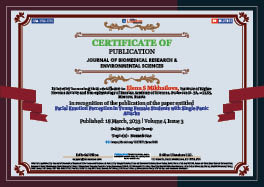Elena S Mikhailova*
Volume4-Issue3
Dates: Received: 2023-02-18 | Accepted: 2023-03-14 | Published: 2023-03-18
Pages: 454-457
Abstract
The study aimed to examine the behavioral and neural correlates of facial emotion recognition in a non-clinical group of 13 young female students with single Panic Attacks (PA) compared to 14 matched healthy controls. Subjects were asked to recognize angry, fearful, happy, disgusted, sad and surprised faces, and reaction time and Event-Related Potentials (ERPs) were recorded. Significant between-group differences in reaction time were not found, but the PA subjects reacted more slowly to angry and fearful expressions. More distinct between-group differences were observed in the EPRs: the PA subjects demonstrated increased amplitudes of the P100 components in the occipital area. The increased amplitude of the occipital P100 component for threat-related faces suggests that this type of high-arousal negative emotions is particularly meaningful for the PA individuals.
FullText HTML
FullText PDF
DOI: 10.37871/jbres1696
Certificate of Publication

Copyright
© 2023 Mikhailova ES. Distributed under Creative Commons CC-BY 4.0
How to cite this article
Mikhailova ES. Facial Emotion Perception in Young Female Students with Single Panic Attacks. 2023 Mar 18; 4(3): 454-457. doi: 10.37871/jbres1696, Article ID: JBRES1696, Available at: https://www.jelsciences.com/articles/jbres1696.pdf
Subject area(s)
References
- Fonzo GA, Ramsawh HJ, Flagan TM, Sullivan SG, Letamendi A, Simmons AN, Stein MB. Common and disorder-specific neural responses to emotional faces in generalised anxiety, social anxiety and panic disorders. Br J Psychiatry. 2015 Mar;206(3):206-15. doi: 10.1192/bjp.bp.114.149880. Epub 2015 Jan 8. PMID: 25573399.
- Helmchen H, Linden M. Subthreshold disorders in psychiatry: clinical reality, methodological artifact,and the double-threshold problem. Compr Psychiatry. 2000 Mar-Apr;41(2 Suppl 1):1-7. doi: 10.1016/s0010-440x(00)80001-2. PMID: 10746897.
- Wang, SM, Kim Y, Yeon B, Lee HK, Kweon YS, Lee C T, Lee KU. Symptom severity of panic disorder associated with impairment in emotion processing of threat-related facial expressions. Psychiatry Clin Neurosci. 2013 May;67(4):245-52. doi: 10.1111/pcn.12039. PMID: 23683155.
- Stevens, E. S., Weinberg, A., Nelson, B. D., Meissel, E. E. E., & Shankman, S. A. (2018). The effect of panic disorder versus anxiety sensitivity on event-related potentials during anticipation of threat. Journal of Anxiety Disorders, 54, 1–10. https://doi.org/10.1016/j.janxdis.2017.12.001.
- Spielberger CD, Gorsuch RL, Lushene R, Vagg PR, Jacobs GA. Manual for the state-trait anxiety inventory. Palo Alto, CA: Consulting Psychologist Press.1983.
- Langner O, Dotsch R, Bijlstra G, Wigboldus DHJ, Hawk ST, Knippenberg A. Presentation and validation of the Radboud Faces Database. Cognition and Emotion. 2010. 24(8), 1377-1388. https://doi.org/10.1080/02699930903485076.
- Shim M, Kim DW, Yoon S, Park G, Im CH, Lee SH. Influence of spatial frequency and emotion expression on face processing in patients with panic disorder. J Affect Disord. 2016 Jun;197:159-66. doi: 10.1016/j.jad.2016.02.063. Epub 2016 Mar 3. PMID: 26991371.
- Rossignol M, Campanella S, Maurage P, Heeren A, Falbo L, Philippot P. Enhanced perceptual responses during visual processing of facial stimuli in young socially anxious individuals. Neurosci Lett. 2012 Sep 20;526(1):68-73. doi: 10.1016/j.neulet.2012.07.045. Epub 2012 Aug 3. PMID: 22884932.
- Eldar S, Yankelevitch R, Lamy D, Bar-Haim Y. Enhanced neural reactivity and selective attention to threat in anxiety. Biol Psychol. 2010 Oct;85(2):252-7. doi: 10.1016/j.biopsycho.2010.07.010. Epub 2010 Jul 23.
- Marinkovic K, Trebon P, Chauvel P, Halgren E. Localised face processing by the human prefrontal cortex: face-selective intracerebral potentials and post-lesion deficits. Cogn Neuropsychol. 2000 Feb 1;17(1):187-99. doi: 10.1080/026432900380562. PMID: 20945179.






























































